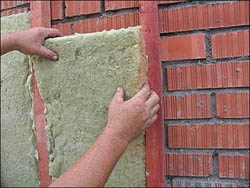The urgent issue for owners of apartments or residential buildings is the installation ...
|
|
Probably, there is not a single person who is completely pleased with the dimensions of his housing ... |
One way to protect your housing from unexpected guests is installation and strengthening ... |
Modern types of insulation for walls

To reduce thermal conductivity of various structures and save a constant comfortable temperature in the rooms, heaters are used. The use of these materials leads to a significant reduction in wall thickness and allows you to significantly save expensive building materials. Modern types of insulation for walls They differ in their characteristics - weight, density, thermal conductivity, endurance to loads, wear resistance, installation method - outside or indoors, and mechanical properties:
“Folding” - are granules from foamed substance of various density and magnitude;
"Vata" - fibers of artificial and mineral origin;
mats - quilted "cotton", sometimes on a synthetic basis;
plates - represent, supposedly soft or hard, porous organic material;
“Plate -Vata” is fibers impregnated with organic binding and formed into plates of various sizes;
wall blocks - light blocks of glass or concrete, foamed in various ways.
To choose and buy the right thermal insulation material, it is necessary to take into account the characteristics that should have different types of insulation for walls. The most important thing is the installation method - external or internal. Then take into account the degree of their thermal conductivity. With less thermal conductivity, a smaller layer of protective material will be required to protect the house. The next most important property of insulation is its ability not to absorb moisture. For thermal insulation materials, as well as for all other structural elements of the house, durability, fire resistance, preferably, lightness, environmental safety, convenience in work and low cost are important.
